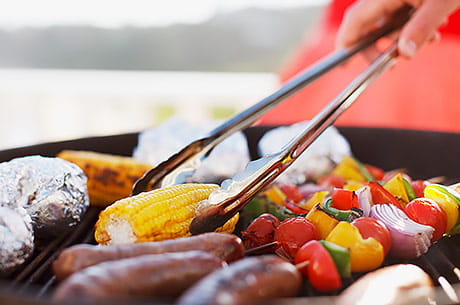Eating healthier this grilling season
8 tips for eating better during your next cookout
Summer means spending more time outside, often gathered around the grill with family and friends. But your next summer cookout doesn’t have to derail your diet. Before you place your food on the grill, a few simple changes can make your summer barbecue a little bit lighter.
Summertime is grilling time
Everyone loves a good meal fresh off the grill. It may be tempting to load up your plate with a main course, a few salty snacks and a heaping helping of some mayo-based picnic salad, but with a few substitutions, you can have a healthier meal that won’t leave you feeling deprived.
“It might not seem like it, but a barbecue is a great opportunity to eat healthy,” says Dr. Hans Zuckerman, family medicine doctor at Geisinger’s Pottsville clinic.
How to lighten up your next barbecue
Before you start shopping for your next summer grilling extravaganza, sit down to plan out your healthy grilling menu.
“Burgers, hot dogs, steaks and other grilled meats tend to be a frequent part of dinner over the summer,” Dr. Zuckerman says. “But it’s also good to add flavorful fruits and vegetables that are low in calories and full of vitamins and nutrients.”
Use this guide to create a healthy summer feast that will make mouths water and leave bellies full.
- Choose leaner proteins, like chicken or lean red meats that are lower in fat and cholesterol. Lean red meat is a good source of iron and vitamin B12, which helps make DNA and keeps red blood and nerve cells healthy. Red meat also contains zinc, which boosts the immune system, and protein, which helps muscle and promotes bone health.
- Consider fish. Salmon and swordfish are rich in heart-healthy Omega-3 fatty acids and offer a unique alternative to traditional grilled fare.
- Go veggie. Opt for veggie burgers or plant-based proteins on the grill. Plant-based products like tofu, lentils or seitan are good sources of protein for vegetarians and vegans. These meatless alternatives are full of fiber and low in saturated fat.
- Swap side dishes, like macaroni salad, with fresh fruit, green salad or grilled summer vegetables. You’ll add some color to your plate while keeping things light.
- Watch your portion sizes. An average serving of meat or protein is 3 ounces, approximately the size of a deck of cards. After you add meat to your plate, fill the rest with fruits and vegetables to satisfy your hunger.
- Save the sugar. Many store-bought sauces are sneaky sources of added sugar and sodium. For a healthier option, try making your own instead. The internet is a great resource to find the perfect marinade recipe. Or, if you’d rather create your own recipe, experiment with ingredients until you find the right blend.
- Choose multigrain buns or rolls. Instead of more traditional white buns or rolls, choose a whole-grain one to add some extra fiber to your meal.
- Fill your glass with sparkling water instead of alcohol, soda or sweetened beverages. To give plain water some pizazz, try adding fresh mint or an infusion of fruit, like lemon or berries.
Moderation is key
A lighter plate doesn’t mean you can’t eat the foods you love or indulge in your favorite barbecue food once in a while.
Dr. Zuckerman reminds, “It’s important to be cognizant of diet and exercise and eat and prepare foods in moderation. For example, you may want to limit grilling and charring meats to just once or twice a week, rather than multiple times. Making smarter food choices means you’ll eat less sodium and saturated fat in your diet. You’ll even feel better, too.”
Next steps:
Do you really need a primary care physician? Spoiler alert: Yes, you do.





